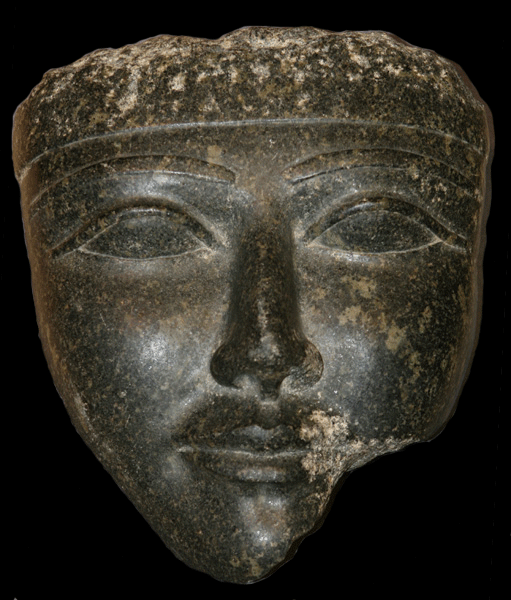Egyptian Granite Head, 600 BCE - 300 BCE
Granite
11.25 x 13.5 cm
4 3/8 x 5 1/4 in
4 3/8 x 5 1/4 in
SK.034
This monumental granite head is a fragment from a stone sarcophagus of the Late Dynastic Period. In its complete state the head would have been attached to a recumbent body...
This monumental granite head is a fragment from a stone sarcophagus of the Late Dynastic Period. In its complete state the head would have been attached to a recumbent body above a large rectangular coffin containing the mummified remains of the deceased. Hieroglyphic inscriptions would have the named the owner and possibly included spells from the Book of the Dead. The expense of the material and the quality of the carving indicate that the sarcophagus belonged to a high ranking official who had both the wealth and the status to place such a commission.
For the ancient Egyptians the furnishing of a tomb could be a life-long occupation. Preparing for the afterlife as well as displaying worldly wealth were the two main concerns. The mummified remains would not have been placed directly within the granite sarcophagus. For extra protection and ceremony another equally elaborate coffin, probably made of a more perishable material such as wood, would have been included inside. Anthropoid-shaped coffins originated during the Middle Kingdom and soon became the standard form. The preservation of the deceased’s image, albeit highly idealised, was considered critical to the soul’s rebirth.
Even the chosen material had a spiritual significance. Royal sarcophagi were often fashioned from black granite which symbolised resurrection and rebirth as black was the colour of the fertile silt deposited by the Nile flood each year. The Egyptians even referred to their country as the “Black Land’ and in the Late Period black stones were often used to fashion images of Isis and Osiris, both deities associated with rebirth.
The style of the carving is reminiscent of the royal sarcophagi of the New Kingdom period and was probably deliberately archaic. By drawing on a prestigious older tradition associated with Egypt’s most illustrious era, the deceased desired to improve their own chances of eternal life. The eyelids and eyebrows are highly stylised but the long nose and full lips are more naturalistic. Despite the loss of the lower right corner, most of the features are excellently preserved. The full cheeks create the impression of youth and beauty. The horizontal band that runs across the forehead suggests that the deceased was portrayed in an elaborate headdress. This is a remarkable survival that deserves to be the centrepiece of any ambitious collection of Egyptian art. (AM)
For the ancient Egyptians the furnishing of a tomb could be a life-long occupation. Preparing for the afterlife as well as displaying worldly wealth were the two main concerns. The mummified remains would not have been placed directly within the granite sarcophagus. For extra protection and ceremony another equally elaborate coffin, probably made of a more perishable material such as wood, would have been included inside. Anthropoid-shaped coffins originated during the Middle Kingdom and soon became the standard form. The preservation of the deceased’s image, albeit highly idealised, was considered critical to the soul’s rebirth.
Even the chosen material had a spiritual significance. Royal sarcophagi were often fashioned from black granite which symbolised resurrection and rebirth as black was the colour of the fertile silt deposited by the Nile flood each year. The Egyptians even referred to their country as the “Black Land’ and in the Late Period black stones were often used to fashion images of Isis and Osiris, both deities associated with rebirth.
The style of the carving is reminiscent of the royal sarcophagi of the New Kingdom period and was probably deliberately archaic. By drawing on a prestigious older tradition associated with Egypt’s most illustrious era, the deceased desired to improve their own chances of eternal life. The eyelids and eyebrows are highly stylised but the long nose and full lips are more naturalistic. Despite the loss of the lower right corner, most of the features are excellently preserved. The full cheeks create the impression of youth and beauty. The horizontal band that runs across the forehead suggests that the deceased was portrayed in an elaborate headdress. This is a remarkable survival that deserves to be the centrepiece of any ambitious collection of Egyptian art. (AM)
